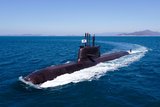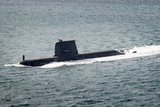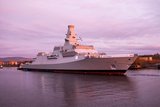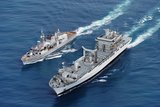Spearfish weapons system passes UK Royal Navy Sea Acceptance test
Testing the Spearfish system on Vanguard-class submarines will allow fleet modernisation to continue. (Photo: Crown Copyright)
The next-generation Spearfish torpedo system has passed its Sea Acceptance testing phase with the UK’s Royal Navy (RN) submarines.
Across three days of testing on board a Vanguard-class submarine off the coast of Scotland, the Spearfish engaged with both surface and submerged targets.
The testing marked the first time the Spearfish had been used on board a Vanguard-class nuclear-powered submarine. It allowed submariners to assess the system’s capabilities with the Vanguard-class’s combat systems, and ensure command and control worked efficiently on the class.
The testing means that the Spearfish has been cleared for use on both the RN's Astute and Vanguard-class submarines.
A version of the Spearfish has been the navy’s go-to torpedo for nearly 30 years but the new version that has just been tested on the Vanguard class is a modernised variant, known as Spearfish Mod 1. It has a new warhead, a safer fuel system and an improved electronic system ad well as a fibre-optic guidance link with its parent submarine to improve its accuracy and lethality.
Commodore Chris Goodsell, deputy director, submarines, said: “These firings are a major step in ensuring the Royal Navy’s Spearfish torpedoes remain ready to face the latest threats, with cutting edge technology at the forefront of the weapon’s success”.
Work is ongoing to replace existing Spearfish torpedoes with the Mod 1 version for entry into operational service on board all RN submarines by 2025.
Related Equipment in Defence Insight
More from Naval Warfare
-
![New UK-Norway pact covers warship, missile and autonomous system collaboration]()
New UK-Norway pact covers warship, missile and autonomous system collaboration
The Lunna House Agreement represents multiple opportunities for cooperation between the two navies, and follows on from last year’s declaration of a joint strategic partnership between the countries.
-
![How will the Canadian Coast Guard’s transfer to the DND umbrella affect its capabilities?]()
How will the Canadian Coast Guard’s transfer to the DND umbrella affect its capabilities?
By joining the defence department, the coast guard will need to acquire new solutions and adapt its in-service capabilities to ensure interoperability with the Canadian Armed Forces.
-
![UK MoD’s confirmation of MBDA missile for Type 26 points to more European collaboration]()
UK MoD’s confirmation of MBDA missile for Type 26 points to more European collaboration
The Type 26 will also be fitted with the Sea Ceptor vertically launched air defence system that can fire CAMM missiles and a 24-cell Mk 41 vertical launch system that can fire the Tomahawk land-attack cruise missiles, anti-submarine rockets and long-range anti-ship missiles.
-
![Second Royal Canadian Navy Joint Support Ship is on schedule to be launched mid-2026]()
Second Royal Canadian Navy Joint Support Ship is on schedule to be launched mid-2026
While the first Joint Support Ship is currently in the final stages of outfitting, the second one is on schedule for launching next year.





















